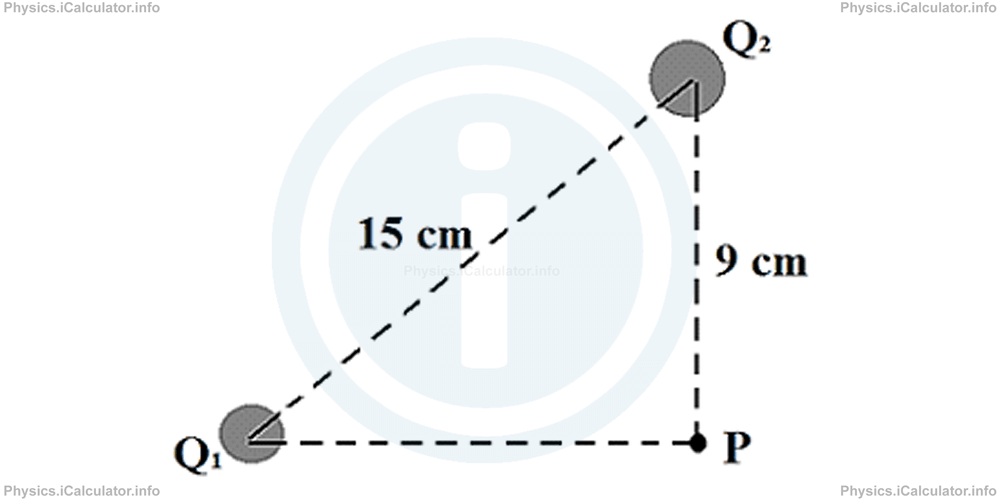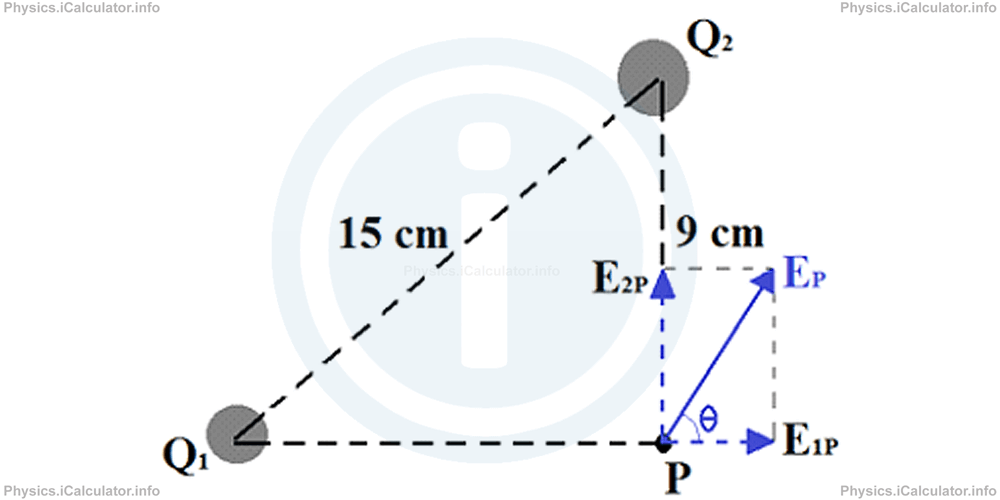Menu
Physics Lesson 14.3.4 - The Superposition Principle
Please provide a rating, it takes seconds and helps us to keep this resource free for all to use
Welcome to our Physics lesson on The Superposition Principle, this is the fourth lesson of our suite of physics lessons covering the topic of Electric Field, you can find links to the other lessons within this tutorial and access additional physics learning resources below this lesson.
The Superposition Principle
If in a given region of space there is more than one charge that produce their own electric fields E1, E2, + En, the net electric field in that region is the sum of all individual electric field vectors, i.e.
Example 2
Two point charges Q1 and Q2 where Q1 = + 20 μC and Q2 = - 30 μC are placed as shown in the figure.

- What is the magnitude of net electric field at the point P?
- What is the angle formed by the vector of net electric field at P to the horizontal direction?
Solution 2
a) First, we find the distance from Q1 to P. Using the Pythagorean Theorem, we have
= √152 - 92
= √225 - 81
= √144
= 12 cm
Now, we find the individual electric fields E1P and E2P where E1P vector is only horizontal (due right, as the electric field lines start from Q2 and extend to infinity) and E2P is only vertical (upward, as the electric field lines start from infinity and end to Q2 because the charge Q2 is negative).
We have:
= 9 × 109 × 20 × 10-6/0.122
= 180 × 10-6/0.0144
= 1.8 × 10-4/1.44 × 10-2
= 1.25 × 10-2 N/C
Also,
= 9 × 109 × -30 × 10-6/0.092
= -270 × 10-6/0.0081
= -27 × 10-5/8.1 × 10-3
= -3.33 × 10-2 N/C
The magnitude of the resultant electric field at the point P therefore is
= √(1.25 × 10-2 )2 + (-3.33 × 10-2 )2
= √1.625 × 10-4 + 11.111 × 10-4
= √12.736 × 10-4
= 3.569 × 10-2 N/C
The vector of resultant electric field at the point P is shown in the figure below.

b) The angle θ formed by the vector of resultant electric field to the horizontal direction is obtained by calculating its tangent. Thus, we have
= |-3.33| × 10-2/|1.25| × 10-2
= 3.33/1.25
= 2.664
Therefore, the angle θ is
= 69.40
You have reached the end of Physics lesson 14.3.4 The Superposition Principle. There are 6 lessons in this physics tutorial covering Electric Field, you can access all the lessons from this tutorial below.
More Electric Field Lessons and Learning Resources
Whats next?
Enjoy the "The Superposition Principle" physics lesson? People who liked the "Electric Field lesson found the following resources useful:
- Superposition Principle Feedback. Helps other - Leave a rating for this superposition principle (see below)
- Electrostatics Physics tutorial: Electric Field. Read the Electric Field physics tutorial and build your physics knowledge of Electrostatics
- Electrostatics Revision Notes: Electric Field. Print the notes so you can revise the key points covered in the physics tutorial for Electric Field
- Electrostatics Practice Questions: Electric Field. Test and improve your knowledge of Electric Field with example questins and answers
- Check your calculations for Electrostatics questions with our excellent Electrostatics calculators which contain full equations and calculations clearly displayed line by line. See the Electrostatics Calculators by iCalculator™ below.
- Continuing learning electrostatics - read our next physics tutorial: Electric Potential Energy
Help others Learning Physics just like you
Please provide a rating, it takes seconds and helps us to keep this resource free for all to use
We hope you found this Physics lesson "Electric Field" useful. If you did it would be great if you could spare the time to rate this physics lesson (simply click on the number of stars that match your assessment of this physics learning aide) and/or share on social media, this helps us identify popular tutorials and calculators and expand our free learning resources to support our users around the world have free access to expand their knowledge of physics and other disciplines.